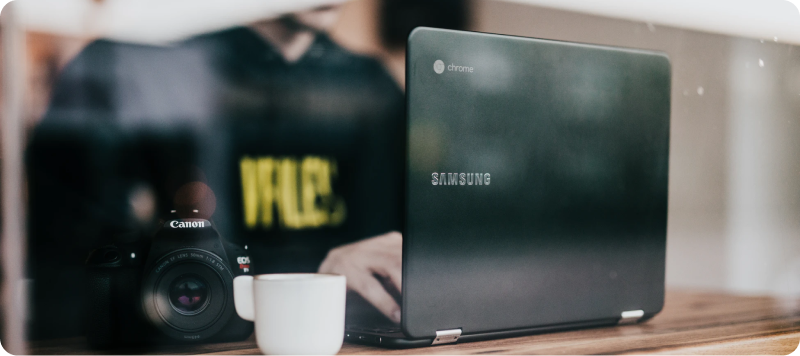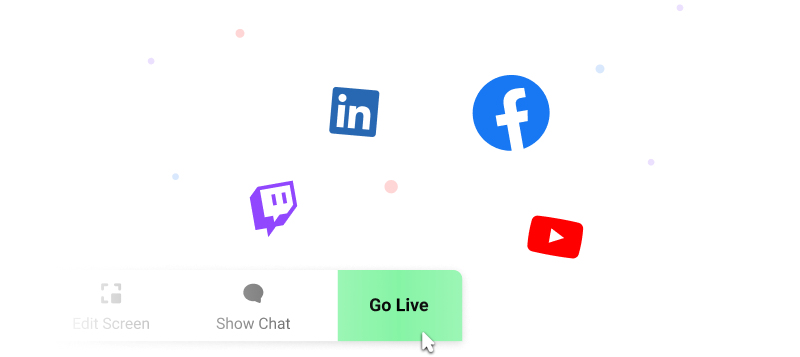It’s no secret that the live streaming space is on fire. Everyone from up-and-coming creators to professionals and small businesses is live streaming to grow their presence online. There is a ton of online content about how to stream from desktop PCs. There is powerful software like Streamlabs Desktop or Xsplit that you can download on your computer. There are even many software options to live stream directly from your phone, like Streamlabs Mobile. But what about streaming from a Chromebook?
This is a comprehensive guide to streaming from your Chromebook. We will cover everything in simple terms so that you can go from reading this straight to your first stream from your Chromebook.
Why Should You Live Stream?
People get into live streaming for many reasons. For some, it is a fun hobby. For others, it is a way to express themselves. Some people use it as a way to connect with like-minded people. Then, there are those that stream professionally and rely on it as their primary source of income. Your motivation for live streaming may be personal. However, it's important to know your why, as it will guide you when making decisions regarding live streaming.
Picking a Live Streaming Platform
Twitch is a popular live streaming platform that boasts the largest engagement in the live streaming community. Twitch is known primarily for the gaming audience but has also experienced a rise of Just Chatting (conversational, open dialogue) streaming. There are now education channels, music channels, cooking shows, and more. It’s also worth noting that Twitch is owned by Amazon.
YouTube is the largest search engine in the world after Google. Live streaming to YouTube has enormous benefits, given the reach of YouTube. If you already have a presence on YouTube, you can benefit from your existing community there. Similar to Twitch, YouTube has a number of commerce options to help you monetize your livestream. To learn more about live streaming on YouTube Live, you can check out our helpful guide.
Facebook is another wildly popular social platform. One of the benefits of streaming to Facebook is that if you belong to a Facebook group and have the right to stream to that group, you may automatically have an audience. The same goes for your friends—if you have a list of friends on Facebook and you live stream to your feed, you already have a few viewers. This enables you to get past that difficult hump of starting from zero. Facebook also offers a solid number of commerce options. This guide has even more info on how to livestream on Facebook.
LinkedIn is yet another platform you can stream to. To stream to LinkedIn live, you need to be a verified broadcaster. When you stream to LinkedIn, you tap into a massive network of professionals. Your broadcasts will naturally be different in nature and should not be gaming focused.
There are many other platforms where you can stream, such as Kick, Twitter, Trovo, and others. While most of these places have integrations for Talk Studio or Streamlabs Desktop, you can stream via custom RTMP for those that don’t. Check out this guide for more information on how to think about which live streaming platform is best for you.
Of the platforms mentioned, YouTube and Twitch are the most popular for live streaming. For tips on getting started streaming on YouTube Live, you can check out our YouTuber University, starting with our guide on setting up and branding your YouTube channel. If you’re thinking about jumping into streaming on Twitch, our Twitch streaming guide is the perfect place to start.
No matter what platform you choose to stream on, be sure to check all the community guides and terms of service before streaming. Also, take all necessary steps to fully set up your account on any platform.
Understanding the Fundamentals of Streaming on a Chromebook
When it comes to Chromebooks, most of them are equipped with integrated graphics rather than discrete GPUs. Integrated graphics means that the graphics processing is handled by the same chip (CPU) that performs other tasks on the computer. This design helps keep Chromebooks slim, lightweight, and more power-efficient.
While integrated graphics are generally sufficient for everyday tasks like web browsing, video streaming, and basic productivity, they may not offer the same level of performance as a dedicated discrete GPU found in traditional laptops or desktop computers. Discrete GPUs are often used for more graphics-intensive activities like gaming or professional video editing, which are not the primary focus of most Chromebooks. This means that Chromebooks are not going to be the best option for gaming and especially for gaming and live streaming simultaneously. However, with browser-based software like Talk Studio, you can stream much more efficiently, regardless of these limitations.
Ensure a Stable Internet Connection
If you have a Chromebook, you likely have an internet connection since it is a web-first computer. For live streaming, especially, you want to make sure you have a stable internet connection. Being plugged in directly into the internet and or being close to the router will help for signal strength.
Pick a Live Streaming Tool
Assuming you have your Chromebook, internet, microphone, camera, and streaming platform account setup, it’s time to pick a live streaming app.
Talk Studio: This is our top pick. It is a web-based live streaming studio that enables creators to go live with ease. You can broadcast to social media sites such as Facebook, YouTube, Twitter, or Twitch and go live in just a few clicks. Built by the team at Streamlabs, there is no complicated setup and nothing to install for you or your guests. With Talk Studio, everything is hosted on best-in-class cloud infrastructure, meaning podcasters, brands, businesses, and individuals get blazing-fast response time, low CPU usage, and minimal latency. Not to mention, Talk Studio starts at just $9 per month..
FYI, streamers can upgrade to Streamlabs Ultra to get access to the pro features of Talk Studio, like multistreaming and inviting up to 24 guests to your live stream (with 15 visible on screen at a time), in addition to other premium apps created specifically for streamers and creators (including Streamlabs Desktop).
Streamyard: This is also a strong option. StreamYard has a limited free option that is good for testing, but for most features you'll have to pay for the Core ($44.99 per month) or Advanced package ($88.99 per month).
Restream: This platform is famous for enabling people to livestream to 30+ destinations. Anyone can use the service, but the majority of the features are most beneficial to entrepreneurs, marketers, and corporations. The standard plan, currently priced at $19 per month, costs more than twice Talk Studio’s monthly plan.
Native Streaming vs. Streaming Software
Most streaming platforms have built-in ways to get you going live. However, there are some tradeoffs and limitations, especially when streaming from a Chromebook.
Twitch Studio: Requires a download and will not work well on Chromebooks due to GPU limitations, as mentioned earlier.
YouTube Studio: This works nicely in the browser, but it will lack a lot of the options, such as inviting guests for collaborative streams, integrated donations that help you monetize your stream, and the level of customization that tools like Talk Studio offer.
Facebook Live: Limitations are similar to that of YouTube Live.
Can I Live Stream Video Games from My Chromebook?
Good question. The simple answer is it may work for some lighter games or browser-based games, but we do not highly recommend it. You are always welcome to try and experiment.
First, you are going to be limited by the games you play because Chrome books do not have a discrete GPU. For gaming, we generally recommend standard PC laptops. You can play web-based games and get them from Steam. You can also get an Android emulator such as Blue Stacks and play Android games. When you play video games on your Chromebook, you can share screen and live stream. Talk Studio allows you to do that with ease. Just be mindful of the apps running in the background for maximum performance. Check out this guide on screen sharing and live streaming with Talk Studio.
Preparing for Your First Live Stream Using Your Chromebook
There is a lot that can be written here. For an in-depth guide, check out this blog for general tips on live streaming. Below are some of our quick recommendations.
Start simple: Chromebook and Talk Studio will work very well for your live streaming needs.
Secure good lighting: Good lighting does not even mean fancy lights. It just means a well-lit room to enhance the overall quality of your live stream. Check out our guide for the best lighting options for live streaming
Use a stable internet connection: As a browser-first device, having a stable internet connection is vital—especially if you plan on live streaming using a platform such as Talk Studio.
Run a test stream: Yes, you can do a quick stream to Twitch and delete it to make sure everything is running smoothly. Also, you can live stream to a private or unlisted YouTube channel.
Keep experimenting: Try different titles, schedule streams to let your audience know when to tune in in advance, invite guests to your livestream, etc. The great thing about just starting out is that you can find your groove.
Engage with chat: The chat is the heart and soul of your live stream. Make sure you acknowledge your viewers and engage with them whenever you get a chance.
Record your livestreams: You can repurpose your live streams on other platforms or even study them. FYI, Talk Studio also allows seamless live streaming and recording simultaneously.
Stay professional: Your live stream is yours to own, but do not break any platform's terms of service and risk being banned. Think long-term and think about your brand.
Promote your live stream on social media: Take the time to engage with people outside your live streaming platform and use tools available to promote on social media. For example, with Talk Studio, you can auto-post to Twitter when you go live.
As you can see, there are quite a few nuances that make streaming on a Chromebook a bit different from streaming on a PC or Mac. We hope this guide is able to help you confidently get started with streaming on a Chromebook today!